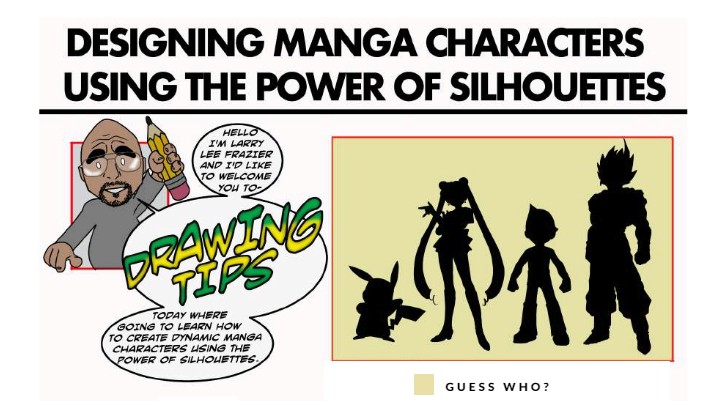
By Larry Frazier
Guess Who?
Silhouettes can be used to create unique character designs, helping distinguish characters from one another. I bet you can recognize these guys by just glancing at them.
The Eye of the Beholder
It is said the eyes are the gateway to the soul. In Manga, nothing could be farther from the truth. The eye shape is a key element of a character design when it comes to Manga. For example, large saucer-shaped eyes can convey a cute, innocent, or perhaps naïve character archetype. Sharp, narrow eyes can have the opposite effect, indicating a much more solemn result. This is suitable for more powerful characters such as villains, heroes, or even more jaded characters. Another thing to consider is that eye shapes can change from scene to scene, expressing emotions such as anger or surprise.
Tip: Create different eye shapes and different combinations by adding a variety of line styles, from thick to thin. Try different shapes and use a plethora of colors and highlights.
Just Do It
When it comes to hairdos, calling them extravagant would be an understatement, but much like eye shapes, they are pivotal in shaping the overall look and personality of the subject. Once again, this is all about expression. Try out different styles and combinations to see what outcome works best. Think of your favorite characters and how the hair design affects their overall aesthetics. Ninety percent of all visual weight comes from the face. This is how we read or analyze expressions when interacting with one another. As you can see, the combination of eye shapes and hairstyles is essential in creating easy and readable original characters.
When drawing characters using the silhouette process, consider the overall shape and language of the figure. Is he/she tall or short? What types of stance or pose will they be in? What type of character are they going to be? Perhaps a Rogue, Tank, or Knight? Each would have its unique “shape language.” Try to create a distinct shape that will set your character apart from others. In the example below, I was going for a rogue Samurai type of character. If you observe the subject’s shape language, you’ll notice three specific aspects that help him stand out: the baggy MC Hammer pants, the torn poncho, and the Samurai man bun, which add to the final build of the character. A great silhouette has great power in simplifying the nature of a character, creating a comprehensive and clearly realized idea.
The Drawing Process
- Step 1: Open a new file. Select a hard, round brush. Begin roughly sketching out your figure while considering what you learned earlier. Use your eraser tool to clean up and create nice, crisp edges.
- Step 2: Create a new layer and fill it with white. Reduce the opacity between 80-45 percent. Open another layer and proceed to make a slightly more detailed sketch.
- Step 3: Create yet another layer and fill it with white, then reduce the opacity. Create one more layer to start the final drawing process while working out the overall details and features.
The Final Steps
The last two steps I would like to discuss are line weights and greyscale. Adding a line weight to the overall drawing helps to ground the figure into the plan while giving the body a rhythm, which gives our subject a 3D feel. By trying out different line weights, you will find out what works for you. Explore. There’s no wrong answer here, and most of all, have fun.
I chose a greyscale palette for a cell-shaded look. When rendering your figure, keep in mind the light source and stay consistent throughout the whole process. Painting in greyscale can be a blessing and a curse. While it has its strengths, such as using it as a base for creating multiple color schemes, the process can also be daunting if you’re not experienced with painting over a greyscale drawing. Your painting might come out muddy or dark, but don’t let that stop you. Keep trying.
Backstory
Try using visual cues to generate information about your character at first glance. I like to call these little bits “info backstory.” Notice how the ball and chain, the scars, and the eye patch give you a little insight into what type of character he might be.
